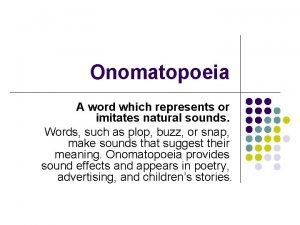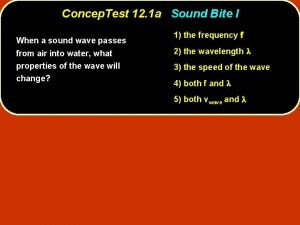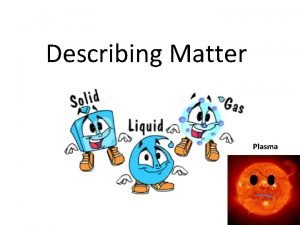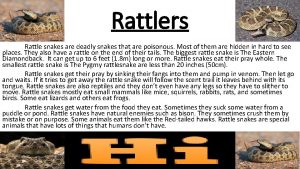The whistle and the rattle The design of












![Importance of calcium transient? [Ca 2+] transient signifies the rate at which the muscle Importance of calcium transient? [Ca 2+] transient signifies the rate at which the muscle](https://slidetodoc.com/presentation_image_h/2c9e9f9de62915a2cafc301c91e8e4a8/image-13.jpg)















![Question 11 What is the importance of the [Ca 2+] transient? Question 11 What is the importance of the [Ca 2+] transient?](https://slidetodoc.com/presentation_image_h/2c9e9f9de62915a2cafc301c91e8e4a8/image-29.jpg)



- Slides: 32

The whistle and the rattle: The design of sound producing muscles (Rome et al. ) KELLY, JESSICA, TINA, ALLISON

1. 2. Muscle Review 3. 4. Sherwood Fig. 8 -11

Sherwood Fig. 8 -6

Red vs. white vs. swim bladder muscles Red muscle: ● Slow twitch fiber ● Contracts slowly and releases ● energy gradually ○ Good for endurance Required by the body during steady-state activity ○ Efficient in using oxygen to generate energy (ATP) and in making muscles resistant to fatigue White muscle: ● Fast twitch fiber ● Contracts quickly and ● releases energy rapidly, BUT fatigues rapidly ○ Due to anaerobic metabolism The body recruits fast twitch fibers to perform explosive activities such as weightlifting, field athletics, and sprint track athletics

Swim bladder muscle The swim bladder is a large chamber of air ● It is located in the abdominal cavity in most bony fishes. Functions include: ● Regulation of buoyancy ○ By regulating air intake ● Production of sound ○ Sonic muscles located on the swim bladder. ■ Contract at super fast frequencies, causing the swimbladder to vibrate

Remember the snake?

The whistle and the rattle ● Main point of the research paper: ○ To find the necessary components needed for toadfish muscles to produce sounds. ● Summary of abstract: ○ Vertebrate sound producing muscles are the fastest muscles, operating at frequencies exceeding 100 Hz. These muscles require calcium to be released and taken back up by the SR very quickly. ○ The “boatwhistle” mating call is about ≈200 Hz. These muscle fibers must have extreme adaptations in order to function properly. ○ A swimbladder muscle must have: ■ A large and very fast calcium transient ■ A fast crossbridge detachment rate ■ A fast kinetic off-rate of calcium from troponin

Sherwood Fig. 8 -6

Toadfish mating call (video) “Boatwhistle” mating call

Introduction Two of the fastest vertebrate muscles known: • The “boatwhistle” mating call of the male toadfish is generated by ≈200 Hz contractions. • The familiar “rattle” of the venomous western diamondback rattlesnake is generated by ≈90 Hz contractions. Both of these sonic muscles are used to produce sounds at the frequency at which the muscle contracts. The operational frequencies of these sonic muscles are 1 -2 orders of magnitude higher than those of the muscles for movement in the same animal (0. 5 -5 Hz).

Methods Dissected different muscles fibers of the toadfish: red, white, and swim bladder ● Myoplasmic Ca 2+ Transient ○ ● Muscle Mechanics ○ ● Muscle fibers were succumbed into different physiological tests (stretching, etc. ) Force-p. CA Measurements ● ● Monitored free [Ca 2+] (in the myoplasm) within each fiber type via furaptra Done to determine Ca 2+sensitivity Modeling ○ To find K(off) rate

Results ● Because of low operational frequencies; ○ type: red and Twitch white fibers are notgood at making Muscle Time Tetanic force sound fusion ● It was still needed to test for the 3 conditions hypothesized. Red/ slow 500 ms 5 -10 Hz ● Calcium Transient is proportional for the length of Twitch time (B) White/ fast 100 ms 10 -15 Hz ○ Swimbladder has the fastest Ca transient Swimbladder 10 ms (3 -4 ms) for 100 -200 Hz ever recorded any fiber type ○ (this proves the 1 st requirement true)
![Importance of calcium transient Ca 2 transient signifies the rate at which the muscle Importance of calcium transient? [Ca 2+] transient signifies the rate at which the muscle](https://slidetodoc.com/presentation_image_h/2c9e9f9de62915a2cafc301c91e8e4a8/image-13.jpg)
Importance of calcium transient? [Ca 2+] transient signifies the rate at which the muscle fiber relaxes. A. [Ca 2+] does not drop fast enough and so concentration levels will always be above threshold a. No force is ever generated b. Relaxation is not complete

p. Ca & Modeling Change in Ca 2+ sensitivity Results: ● The frog fiber muscles were used as a reference because K-off is known ○ White fibers are less sensitive to Ca 2+ than red fibers ○ Swim bladder fibers are even less sensitive ○ A 3 -fold right shift determines that the K-off of the swim bladder fibers is 3 x faster than the frog ***

Muscle Mechanics ● Velocity x Force graphs were determined by attaching fibers to force transducers ○ Fibers were stretched at different lengths ● Vmax is known to be consistent to detachment rate ● Vmax of swimbladder is 12 ML/s

Conclusion ● All 3 components were proved correct ● Ultrastructural and biochemical studies also demonstrate that there is an increase in SR pump density ○ As well as the potential in SR and mitochondria density ■ Leading to an increase in Ca 2+ release, and calcium pumps ○ Like in the rattlesnake shaker

References Crowther, Greg. "B Bio 352 Spring, 2015 Muscles. " , . 12 Apr. 2015. Lecture. "DOSITS: How Do Fish Produce Sounds? " DOSITS: How Do Fish Produce Sounds? University of Rhode Island, Graduate School of Oceanography. Web. 26 May 2015. "Gulftoadfish. " Florida Museum of Natural History. Web. 26 May 2015. "Listening to the Song of the Toadfish. " The Song of the Toadfsih. San Francisco State University, 2010. Web. 26 May 2015. "PDHPE. " HSC Online. State of New South Wales, Department of Education and Communities and Charles Sturt University, 2015. Web. 26 May 2015. Sherwood, Lauralee, Hillar Klandorf, and Paul H. Yancey. Animal Physiology From Genes to Organisms. 2 nd ed. Yolanda Cossio, 2013. (PAGES). Print.

Toadfish Trivia! • Get into three groups. • Each group will stand an equal distance from the white board. • For each question, one person from each group will run to the white board and write down the answer. • The team that correctly answers the question first will receive 1 point. • The team who has the most points at the end of the game wins!!

Question 1 Which muscle type is associated with fast twitch fibers?

Question 2 What are the two functions of the toadfish swim bladder muscle?

Question 3 What is the name of the fluorescent dye?

Question 4 What does myosin detach from?

Question 5 What kind of contraction frequency is needed for the swimbladder to produce sound?

Question 6 What does calcium bind to?

Question 7 What is the toadfish muscle sound called?

Question 8 At what frequency does the swimbladder produce sound?

Question 9 What is the name of the type of muscle that produces sound?

Question 10 Which type of muscle is used to perform explosive activities? (i. e. weight-lifting, field athletics, sprint track athletics)
![Question 11 What is the importance of the Ca 2 transient Question 11 What is the importance of the [Ca 2+] transient?](https://slidetodoc.com/presentation_image_h/2c9e9f9de62915a2cafc301c91e8e4a8/image-29.jpg)
Question 11 What is the importance of the [Ca 2+] transient?

Question 12 Rank the order of sensitivity of muscle fibers to calcium. (from smallest to largest)

Question 13 Name one of the three components that the swim bladder muscle must have in order for it to produce sound.

Question 14 (for +2 points) Give us your best “boatwhistle” mating call imitation!!
 Rattle spine nms
Rattle spine nms Onomatopoeia in sentences
Onomatopoeia in sentences F f# g g# a a#
F f# g g# a a# Windy whistle
Windy whistle Traffic whistle signals
Traffic whistle signals Inadvertent whistle
Inadvertent whistle Classification of emulsifying agents ppt
Classification of emulsifying agents ppt Write the proportion of acacia for fixed and volatile oil
Write the proportion of acacia for fixed and volatile oil A policeman's whistle has a _____.
A policeman's whistle has a _____. Cooker whistle counter app
Cooker whistle counter app Whistle
Whistle A tea kettle begins to whistle physical or chemical change
A tea kettle begins to whistle physical or chemical change Paralell circuit
Paralell circuit Business ethics whistle blowing
Business ethics whistle blowing Kalimat tak bersubjek dan tak berpelengkap disebut kalimat
Kalimat tak bersubjek dan tak berpelengkap disebut kalimat Painted stations whistle by
Painted stations whistle by Bean whistle
Bean whistle The referee blew his whistle
The referee blew his whistle System and form design example
System and form design example Hát kết hợp bộ gõ cơ thể
Hát kết hợp bộ gõ cơ thể Lp html
Lp html Bổ thể
Bổ thể Tỉ lệ cơ thể trẻ em
Tỉ lệ cơ thể trẻ em Voi kéo gỗ như thế nào
Voi kéo gỗ như thế nào Thang điểm glasgow
Thang điểm glasgow Chúa sống lại
Chúa sống lại Các môn thể thao bắt đầu bằng tiếng chạy
Các môn thể thao bắt đầu bằng tiếng chạy Thế nào là hệ số cao nhất
Thế nào là hệ số cao nhất Các châu lục và đại dương trên thế giới
Các châu lục và đại dương trên thế giới Cong thức tính động năng
Cong thức tính động năng Trời xanh đây là của chúng ta thể thơ
Trời xanh đây là của chúng ta thể thơ Mật thư tọa độ 5x5
Mật thư tọa độ 5x5 Phép trừ bù
Phép trừ bù























































